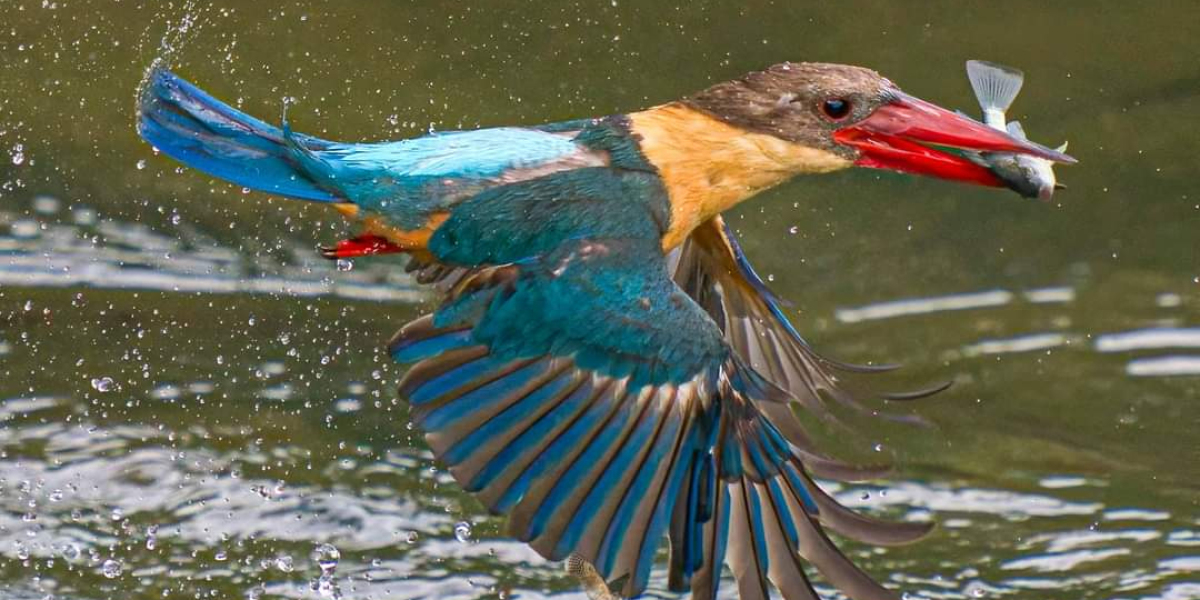# The Enchanting Stork-Billed Kingfisher: A Tropical Beauty
The tropical Indian subcontinent and Southeast Asia are home to a remarkable avian species known as the Stork-Billed Kingfisher (Pelargopsis capensis). This captivating bird, with its vibrant colors and distinctive features, has captivated bird enthusiasts and nature lovers alike. In this article, we will delve into the world of the Stork-Billed Kingfisher, exploring its habitat, physical characteristics, behavior, and the significance it holds in its ecosystem.
## Habitat and Distribution
The Stork-Billed Kingfisher is widely but sparsely distributed throughout its range. It can be found in various habitats, including mangroves, wetlands, rivers, lakes, and forested areas. These stunning birds are prevalent in countries such as India, Sri Lanka, Bangladesh, Thailand, Malaysia, and Indonesia. They have adapted to a wide range of environments, making them versatile and resilient in their quest for survival.
## Physical Characteristics
The Stork-Billed Kingfisher is a sight to behold, measuring about 41-48 centimeters in length, with a wingspan of approximately 70-85 centimeters. It boasts a robust and sturdy build, making it one of the largest kingfisher species in the region. The bird's most striking feature is its magnificent beak, which measures up to 18 centimeters long. This impressive appendage is red in color with a yellow tip, resembling the beak of a stork, hence its name.
The plumage of the Stork-Billed Kingfisher is a brilliant combination of vibrant colors. Its head, neck, and breast are a deep chestnut or maroon hue, while its underparts are a stunning shade of bright white. The back and wings exhibit a beautiful mix of cobalt blue and black feathers. The bird's eyes are a piercing yellow, adding to its allure.
## Behavior and Feeding Habits
As the name suggests, the Stork-Billed Kingfisher is a skilled fisherman. It perches patiently on branches or other elevated spots, keeping a watchful eye on the water below. Once it spots its prey, the kingfisher dives headfirst into the water, swiftly capturing fish, crustaceans, and even small amphibians. Its powerful beak allows it to snatch its prey with remarkable precision and agility.
Apart from its piscivorous diet, the Stork-Billed Kingfisher also feeds on insects, small reptiles, and occasionally, other small birds. It is an opportunistic hunter, adapting its feeding habits to the available food sources in its surroundings.
## Breeding and Reproduction
During the breeding season, which typically occurs between February and May, the Stork-Billed Kingfisher engages in courtship displays to attract a mate. These displays involve various vocalizations, including loud calls and melodious songs. Once a pair is formed, they work together to build a nest, which is usually located in tree hollows or termite mounds.
The female Stork-Billed Kingfisher lays a clutch of 3-5 white eggs, which both parents take turns incubating. After an incubation period of approximately 20-22 days, the eggs hatch, and the parents tirelessly feed the hungry chicks with regurgitated food. The young birds fledge and leave the nest after about 25-28 days, ready to explore the world on their own.
## Ecological Significance
The Stork-Billed Kingfisher plays a vital role in its ecosystem. As a predator, it helps control the population of fish and small aquatic creatures, maintaining a delicate balance within the food chain. Additionally, during its hunting expeditions, the kingfisher may inadvertently help disperse seeds, aiding in the propagation of plant life in its surroundings.
Moreover, the Stork-Billed Kingfisher serves as an indicator species, reflecting the health of the ecosystems it inhabits. Its presence or absence can provide valuable insights into the overall well-being of wetlands and other water-based habitats.
## Conservation Status and Threats
The Stork-Billed Kingfisher, like many other bird species, faces several threats to its survival. Habitat loss due to deforestation, wetland degradation, and urbanization poses a significant challenge. Pollution and water contamination also affect the quality of the bird's habitat and its prey availability.
Efforts are being made by conservation organizations and local communities to protect the Stork-Billed Kingfisher and its habitat. These include creating protected areas, conducting awareness campaigns, and implementing sustainable land use practices. Public support and education are crucial in ensuring the long-term survival of this magnificent bird.
## Appreciating Nature's Artistry
The Stork-Billed Kingfisher is a true marvel of nature, showcasing the beauty and diversity of avian life in the tropical regions of the Indian subcontinent and Southeast Asia. Its striking appearance, hunting prowess, and ecological significance make it a species worthy of admiration and conservation efforts. Byappreciating and protecting the Stork-Billed Kingfisher, we not only preserve a stunning creature but also contribute to the preservation of entire ecosystems and the delicate balance of nature. So, let us marvel at this tropical beauty and work together to ensure its continued existence for generations to come.







